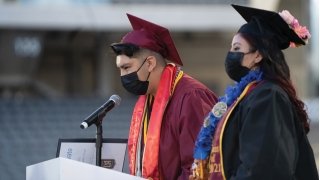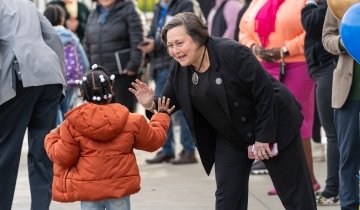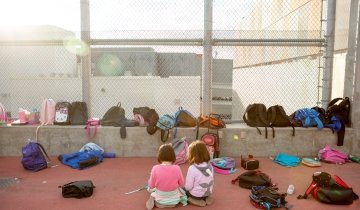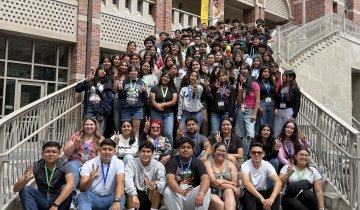When USC Hybrid High College Prep opened in 2012, little about it was traditional, beginning with its location: the ground floor of the bustling World Trade Center in downtown Los Angeles.
“We were a bunch of kids surrounded by all these professionals,” recalled Junior Pena, one of the 90 students from South Los Angeles who formed Hybrid’s inaugural freshman class. “But it was cool to be around them. It elevated our mindset.”
Setting his sights on top-flight colleges, Pena landed at USC, where he earned degrees in math and physics in 2020 before pursuing a doctorate at Massachusetts Institute of Technology.
Hybrid High moved ahead, too. After surmounting early challenges and building its own campus—a light-filled, two-story structure across from the Los Angeles Memorial Coliseum—the school will celebrate its 10th anniversary this fall.
Developed under the auspices of the USC Rossier School of Education and conceived in part to serve students from the neighborhoods surrounding USC, Hybrid is the first of six public, college-preparatory high schools that form the Ednovate network, which focuses on preparing students from traditionally underserved communities for higher education. Ninety-eight percent of Ednovate’s enrollment are students of color—primarily Latinx—while 82 percent come from low-income backgrounds.
Since its first graduation in 2016, Hybrid has achieved a 100 percent college acceptance rate every year except 2020 and 2021, when the rate dipped to 99 percent. Hybrid grads attend college with a persistence rate on par with the national average of 83 percent, according to the National Student Clearinghouse.
Hybrid’s distinctions include a 2018 U.S. News & World Report ranking as one of California’s 100 best high schools. Last year, the California Department of Education named Hybrid a California Distinguished School for exceptional student performance and closing the achievement gap. “Part of our celebration is that in 10 years Hybrid has become one of the top high schools in the country, the city and the state,” said Olumide “Mac” Macaulay, Ednovate’s chief of schools, who was Hybrid’s principal for six years.
There have been stumbling blocks. Many students weren’t ready for the autonomy under Hybrid’s initial plan: to operate up to 12 hours a day, seven days a week, with personalized, self-paced learning—much of it online. “It was not conducive to building a strong school culture,” Macaulay said. Hybrid leaders were able to leverage a deep USC network to adjust the school’s approach with input from then-Dean Karen Gallagher, who was Ednovate’s founding chair, and other experts from USC Rossier. By the end of the second year, Hybrid moved to a more structured approach, which helped lift academic performance. Soon, Hybrid had a long waiting list.
For Rachael DeRogatis, who became principal in 2020, moving Hybrid to its own campus more than three years ago was another major achievement. Hybrid is now located in University Park, just a block from USC.
Being so close to USC “changed our ability to utilize USC as a true partner,” she said. The proximity has made it easier for students to research assignments at Doheny Library, for example, and take undergraduate classes in subjects including transportation and journalism.
Pena spent hours at USC working on his senior thesis even though Hybrid hadn’t yet moved to University Park in 2016. The opportunity to soak up the college atmosphere was invaluable, he said, “because it made that vision of me as a college student something that was actually attainable.”




